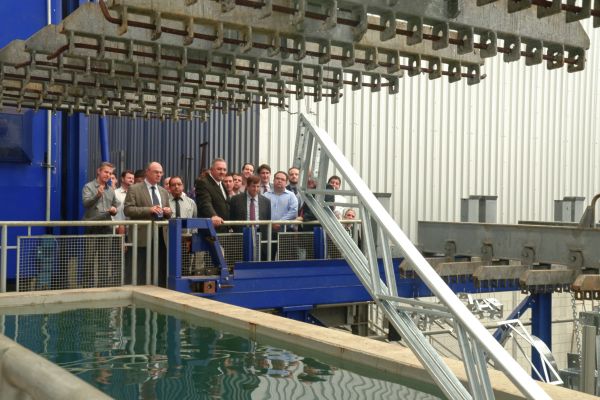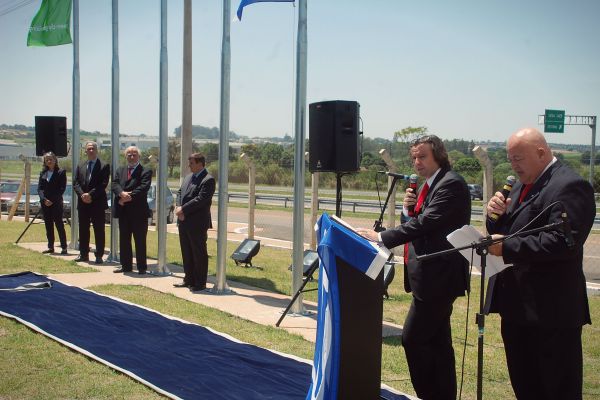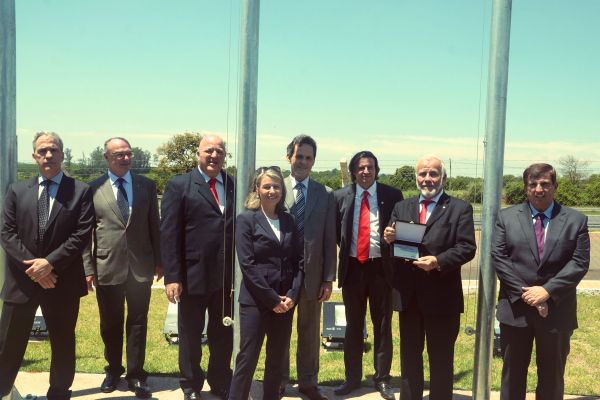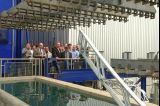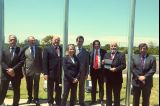Zinkpower invests R$ 60 million and opens hot-dip galvanizing plant in Artur Nogueira
This is the first plant of the Austrian company in Brazil; Project will generate 60 direct jobs and relies on the support from Investe São Paulo
Investe São PauloZinkpower, a global leader in hot-dip galvanizing – a business unit of the Austrian group Kopf –, inaugurated, on October 6, its first plant in Brazil, in Artur Nogueira (SP), 150 km from the state capital.
The project, which relies on the support from Investe São Paulo, the investment promotion agency associated with the Department of Economic Development, Science, Technology and Innovation, includes investments of €15 million (approximately R$ 60 million) and the hiring of approximately 60 employees.
Hot-dip galvanizing is an industrial process that involves dipping steel in zinc at high temperatures, creating a protective layer against rust and corrosion. Among the main products galvanized by Zinkpower are steel structures for construction (arenas, gymnasiums, etc.), agricultural greenhouses, transmission towers, lighting poles, traffic lights and guard rails. The plant will have capacity to galvanize three thousand tons of steel per month.
According to the general manager of the company in Brazil, Martin Feldenheimer, when Zinkpower decided to open a plant in Brazil, it was aware that it would have to be in São Paulo. “That’s where the GDP is higher, in addition to having the largest generation of income. We conducted a survey that identified where the largest manufacturers of steel structures and agricultural irrigation implements were currently located and ended up opting for the metropolitan region of Campinas,” he said.
The company acquired an area covering 60,000 square meters for the construction of the plant, initially with 7,800 square meters of built area. There is sufficient room for the plant to be expanded depending on the market demand. Feldenheimer highlighted the work of Investe São Paulo, assisting the company so that it could find the best location for the project.
“Based on the information we submitted, the Agency provided us with comprehensive information about 18 cities that had the necessary characteristics for the establishment of our company. We assessed which ones had incentive programs and appropriate areas, went through all the information, and ended up deciding for Artur Nogueira. The city is located in a region that has an excellent road network to transport the galvanized product to the entire country,” he said.
According to the president of Investe São Paulo, Juan Quirós, Zinkpower’s investment complements an important industrial chain. “Galvanizing is an important process to increase the quality of various products related to metallurgy. This type of project enriches the industrial park of São Paulo and contributes to the economic development of Brazil,” he says. During the opening ceremony, he was represented by the General Manager of the Agency, Wanius Ribeiro. The project manager Alexandre Marx also attended the opening.
Training
Another factor taken into consideration by Zinkpower when choosing the city was the availability of local workforce. Since galvanizing is basically a manual process, the employees hired are trained by the company, and need no prior technical skills.
“With the harvest mechanization of sugarcane, we noticed that there was a large number of people in Artur Nogueira and neighboring cities who were immediately available to work. Our plant can absorb this workforce and yet train it for the industrial work. Therefore, even after an employee leaves Zinkpower, this person is more qualified for the market,” said the general manager of the company.
Zinkpower is optimistic. According to Feldenheimer, the Kopf Group currently buys large amounts of zinc from Votorantim Metais, which on several occasions has shown to the Austrians that it would be interesting to open a plant in Brazil. That is because the market is growing, since there is too much loss from the corrosion of metals in the country. In addition, the proximity of the Olympic Games should increase the demand for metal structures, which along with agricultural greenhouses and implements, are the most widely galvanized items in Brazil.
Feldenheimer also explained that currently, in the country, many companies end up choosing to paint the metal instead of galvanizing it, for being a simple and inexpensive solution. However, the protection has a shorter duration.
“It’s almost a cultural issue. While Europe consumes from 15 to 20 kilograms of zinc per capita, in Brazil the number does not reach three kilograms. This shows that there is a huge market to be explored. We are conducting an intensive work to disclose the service and raise awareness of customers, the demystifying zinc galvanizing process. Those who know and try it once, ends up doing it always,” he said.
Hot-dip galvanizing
The hot-dip galvanizing process essentially consists of two phases: the first, pickling, cleaning is performed to remove residues or existing corrosions in the metal. Then, the part is submerged in a liquid zinc bath at a temperature of up to 450 degrees Celsius.
This bath means that there is a surface fusion between the zinc and steel, creating a zinc layer on the outer part of the metal. “It is like icing on a cake: there is an outer layer, an inner layer and an intermediate layer with a mixture of both,” said Feldenheimer.
This fusion is the main differential of hot-dip galvanizing in relation to other types of zinc protection. In the electrolytic process, for instance, zinc sticks to the metal by a difference between positive and negative energy. But it is possible to scrape the zinc and remove it, like a paint. In the hot-dip galvanizing process, the two metals are fused.
“Today, the plates used in the production of cars are hot-dip galvanized, that is why they do not rust,” said the general manager of Zinkpower. In the case of Zinkpower’s plants, the process is made with an exclusive green technology, which uses natural light and rainwater harvesting for energy savings. The concept used is the green-dip galvanizing, giving total priority to environmental responsibility in the process.
About Zinkpower
Zinkpower is one of the business units of the Australian group Kopf, which currently employs over 2000 people in 11 countries. The brand is a global leader in the hot-dip galvanizing process and offers the service in 37 establishments located in ten countries in Europe, America and Asia. Its plants are known for the versatility, flexibility, quality and concern for the environment.


